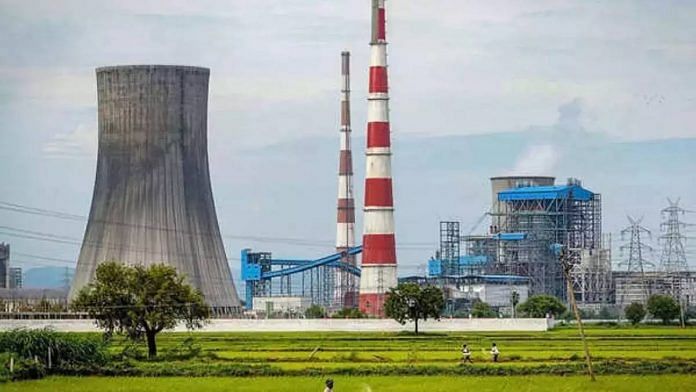Chandigarh: In 2014, Manmohan Singh, then Prime Minister of India, laid the foundation stone for a 2,800-megawatt (MW) nuclear power plant in Gorakhpur village of Haryana’s Fatehabad district. However, after seeing several delays, its first unit is likely to commence operations in June 2028.
Part of the Gorakhpur Haryana Anu Vidyut Pariyojana (GHAVP), an ambitious initiative of the Nuclear Power Corporation of India Limited (NPCIL), the nuclear power plant will be the first in north India. Once complete, it will not only increase the country’s nuclear capacity, but also go a long way in ensuring energy security.
According to India’s Department of Atomic Energy, the country currently has 22 operational nuclear power reactors and an installed nuclear power capacity of 6,780 MW.
Ministry of Power data shows that of India’s total installed generation capacity of 4,16,591 MW, coal accounts for 49.3 per cent, hydro 11.2 per cent, and nuclear only 1.6 per cent.
Haryana chief secretary Sanjeev Kaushal Monday presided over a meeting held in Chandigarh to discuss coordination efforts between officers from the Haryana government and GHAVP for the timely completion of the project.
Niranjan Kumar Mittal, GHAVP Project Director, updated Kaushal about the project’s progress, stating that “74 per cent of the ground improvement work has been completed” and that the “first unit is likely to commence operations in June 2028”.
“Additionally, essential equipment such as end shields and steam generators for the first unit, along with critical reactor components, have been received at the site,” he said, according to a media release.
Speaking to ThePrint, Kaushal said the Haryana government was providing all necessary support for early completion of the project.
“The nuclear power project, the first in north India, will bring prosperity to the area besides generating power,” he added.
When Manmohan Singh had laid the foundation stone of the plant, it was reported that four units of 700-MW capacity each would be developed and be completed at a cost of Rs 23,502 crore.
The project was to be commissioned in two phases. In the first, two units producing 1,400 MW of electricity were to be made operational by 2020-21. The second phase was to start after that, and would double capacity to a full 2,800 MW.
Over the years, however, the project has seen delays for various reasons, the biggest one being the Covid pandemic.
Also Read: Tarapur, India’s 2nd most powerful nuclear plant built with US help, completes 50 yrs today
A nuclear power plant long in making
The idea of a nuclear power plant in Haryana’s Gorakhpur village was first conceptualised way back in 1984 when the area was part of Hisar district. Fatehabad was carved out as a new state district only in July 1997.
The district administration had recommended Gorakhpur village as a good fit for setting up the mega project because of its location in a low seismic zone and a good chance of people giving up land for compensation.
In October 2009, the central government gave an in-principle approval for the 2,800-MW nuclear power plant, and the NPCIL set up an office in Fatehabad district in April 2010.
The government acquired 1,313 acres of land in Gorakhpur and the adjoining Kajalheri village for setting up the plant but faced prolonged protests from the farmers whose land was taken.
Japan’s Fukushima nuclear disaster of 2011 made things more complicated with protests against the nuclear plant increasing and several environmentalists offering support to the agitating farmers, the media had reported.
Among those who visited Fatehabad to express their opposition were former Army Chief General V.K. Singh, now a Union minister.
The farmers ended their protest against the project towards the end of 2012 after the government offered compensation worth Rs 46 lakh per acre.
The NPCIL had also acquired 186 acres in Fatehabad’s Badopal village in 2011 to build a residential colony for its officials and Central Industrial Security Force personnel. However, the local people resisted the move over fears of destruction of the blackbuck habitat, and in June 2018, the NPCIL had to abandon the plan.
It subsequently went on to procure land for the colony in Haryana’s Agroha town.
Chief Secretary Kaushal told ThePrint that “Rs 39.08 crore has been invested so far by NPCIL as part of Corporate Social Responsibility (CSR) initiatives in Gorakhpur village”.
According to the media release, the money has been utilised for various development projects — including the construction of a metalled road along the left bank of the Fatehabad branch canal from Kajalheri to Gorakhpur; the establishment of classrooms, laboratories, libraries, and toilets in nearby schools; construction of gaushalas; creation of a turtle conservation park in Kajalheri; and the provision of a mobile medical van for free treatment and distribution of medications.
Efforts have also been made to enhance the skills of locals and provide scholarships to deserving students, the release said, adding that the residential township being developed at Agroha is at an advanced stage and occupancy of the eight-storey residential towers is expected by June 2023.
(Edited by Nida Fatima Siddiqui)
Also Read: P5 statement on nuclear disarmament is solemn but not credible. Previous treaties are proof



